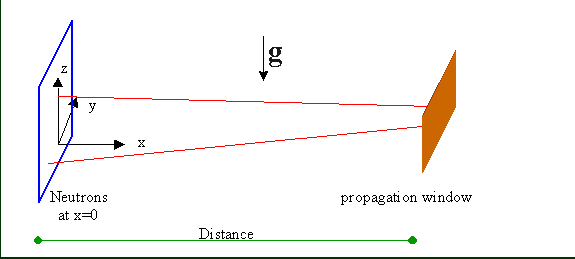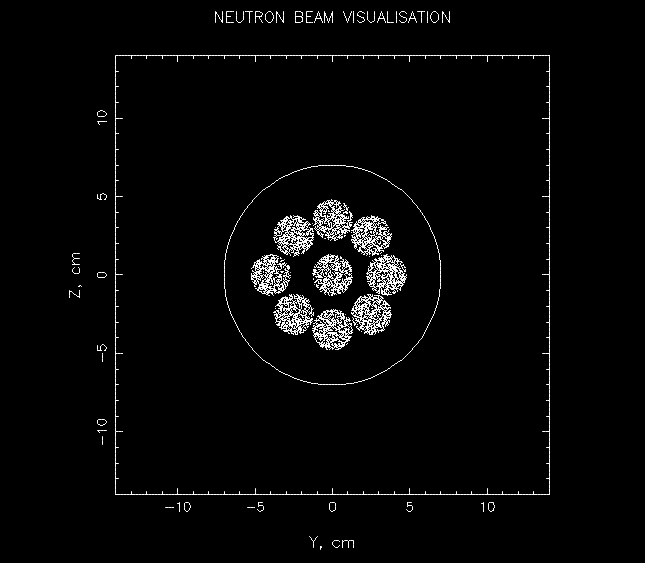VITESS Module MultipleWindows
The module multiplewindows simulates free propagation of neutrons
from (x=0) to the multi-aperture circular collimator (circular slits) or
just characterising a space region of interest. The influence of gravity
can be included in the calculation or omitted(-G option, values 1 or 0).
If gravity is included, neutrons travel from plane x=0 to the collimator
plane on parabolic trajectories. This is very useful for simulating
a SANS (pinhole collimation) instrument with long distances for the long
wavelength range. This collimator represents a window with multiple holes
(with an ideally absorbing circular plate) transmitting the neutrons. The
radius of the circular plate has to be given by the user. The radius and
center position of each hole is described in the parameter file, which
must be created by the user.

The format of parameter file: Y, Z give the center position of the
hole, R the radius of the hole.
Example (two holes):
-10 0.0 2.0
0.0 10.0 3.0
The number of holes for each collimator must be < 100. The number
of lines is equal to the number of holes in the multiple collimator. The
neutrons at x=0 has been calculated by the previous module (naturally they
may differ in y and z-coordinates, divergence, wavelength and time) and
those hitting the holes (or outside of circular plate) are considered further
on in case of ideal transmission or transmited via the "inner material of collimator".
Other neutrons are absorbing in case of ideal absorption or transmitting via
the "outer material of collimator".
Their x-coordinates are reset to 0 as is usually
done by
most of the modules after finishing their specific calculations.
Also the
module calculates the center of the beam at the collimator plate and the
time of flight. The user must give the outer radius of the circular plate
and the distance from the former module to the plate along the x-axis.
(The plate must be perpendicular to the x-direction). An example of visualization
with such a parameter file is given below:
(For visualization use the module monitor or visual (see visual
module help file))

with
-4.0 0.0 1.3
3.5 0.0 1.3
0.0 3.5 1.3
0.0 -3.5 1.3
0.0 0.0 1.3
-2.5 2.5 1.3
2.5 -2.5 1.3
2.5 2.5 1.3
-2.5 -2.5 1.3
---------------------------------------------
There are two kinds of material can be chosen. Outer material is meaning the
"absorbtion" material for the collimator. Inner material is meaning the "transmission"
material for the collimator. The thickness for the each material must be given too.
If the thickness of material is given zero, so for outer material is meaning the ideal
absorbtion. For the inner material is meaning the ideal transmission.
For the inner material data can be red from the file, which has the structure, given
below. If the file is given, the exp. transmission is activating automaticly, otherwise the ideal
transmission is acivated.
List of outer materials, which are included in the module
Value 0 - Read data from file, which created by user
Value 1 - Gd: Gadolinium.
Value 2 - Cd: Cadmium.
Value 3 - B: Bor10.
Value 4 - Eu
Value 5 - Si: Silicon.
Value 6 - Ideal absorbtion
For values 1-4 wavelength range must be 0.3 ... 28 A in the source module or virtual source
Foe value 5 wavelength range must be 1 .. 20 A in the source module or virtual source
This data was given by Thomas Krist, HMI, Berlin.
The format of file, which is describing the transmission is:
Wavelength, A Value MU, cm^(-1)
...............................................................
The wavelength values in the table must be increasing!!!
Then, the transmission is calculated by formula:
Transmission = exp(-MU*Distance);
where Distance is length of flight of neutron in given material in cm, which
calculated automaticly. During passing the neutrons via material, the Transmission
is multiply on the neutron probability.
Please note.
The wavelength range must be from smallest to longest wavelength in the table.
If you used material from list and/or material from file, please choose the
minimal and maximum wavelength values in the source module (or virtual source),
which do not extend the wavelength range for the absorption (outer) and
transmission (inner) materials.
Back to VITESS overview
vitess@hmi.de
Last modified: Tuesday, 03-Jul-2007 16:14:09 CEST

